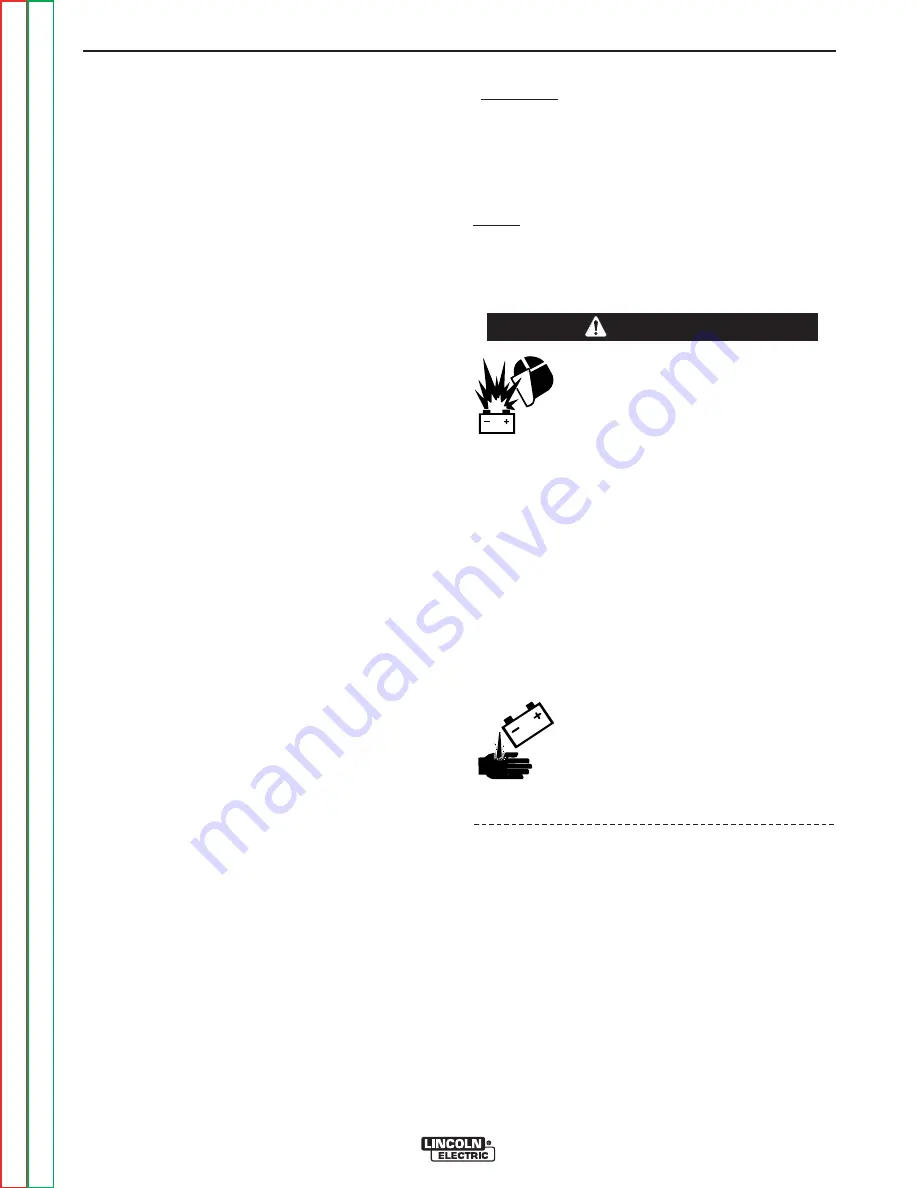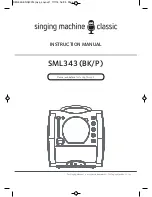
INSTALLATION
A-5
A-5
SAE-400 SEVERE DUTY
Return
to
Section
T
OC
Return
to
Section
T
OC
Return
to
Section
T
OC
Return
to
Section
T
OC
Return
to
Master
T
OC
Return
to
Master
T
OC
Return
to
Master
T
OC
Return
to
Master
T
OC
BATTERY CONNECTION
WARNING:
Use caution as the electrolyte is a strong
acid that can burn skin and damage eyes.
Remove and discard the insulating caps from the neg-
ative battery terminals. Attach and tighten negative
battery cable terminals.
NOTE:
This machine is furnished with wet charged
batteries; if unused for several months, the batteries
may require a booster charge. Be careful to charge the
batteries with the correct polarity. Make sure that the
batteries are level while charging.
GASES FROM BATTERY can explode.
●
Keep sparks, flame and cigarettes
away from battery.
To prevent EXPLOSION when:
●
INSTALLING A NEW BATTERY — disconnect
negative cable from old battery first and
connect to new battery last.
●
CONNECTING A BATTERY CHARGER —
remove battery from welder by disconnecting
negative cable first, then positive cable and
battery clamp. When reinstalling, connect
negative cable last. Keep well ventilated.
●
USING A BOOSTER — connect positive lead to
battery first then connect negative lead to neg-
ative battery lead at the lower control panel
support.
BATTERY ACID can burn eyes and
skin.
●
Wear gloves and eye protection
and be careful when working near
battery.
●
Follow instructions printed on battery.
IMPORTANT:
To prevent ELECTRICAL DAMAGE
WHEN:
a) Installing new batteries.
b) Using a booster.
Use correct polarity —
Negative Ground
.
To prevent BATTERY BUCKLING, tighten nuts on bat-
teries only until snug.
DO NOT OVERTIGHTEN
.
WARNING
ENGINE BREAK-IN
Lincoln Electric selects high quality, heavy-duty indus-
trial engines for the portable welding machines we
offer.
While it is normal to see a small amount of
crankcase oil consumption during initial operation,
excessive oil use, wetstacking (oil or tar like substance
at the exhaust port), or excessive smoke is not normal.
Larger machines with a capacity of 350 amperes and
higher, which are operated at low or no-load conditions
for extended periods of time are especially susceptible
to the conditions described above. To accomplish suc-
cessful engine break-in, most diesel-powered equip-
ment needs only to be run at a reasonably heavy load
within the rating of the welder for some period of time
during the engine’s early life. However, if the welder is
subjected to extensive light loading, occasional moder-
ate to heavy loading of the engine may sometimes be
necessary.
Caution must be observed in correctly
loading a diesel/generator unit.
1. Connect the welder output studs to a suit-
able resistive load bank.
Note that any
attempt to short the output studs by con-
necting the welding leads together, direct
shorting of the output studs, or connecting
the output leads to a length of steel will
result in catastrophic damage to the gener-
ator and voids the warranty.
2. Set the welder controls for an output cur-
rent and voltage within the welder rating
and duty cycle. Note that any attempt to
exceed the welder rating or duty cycle for
any period of time will result in catastrophic
damage to the generator and voids the
warranty.
3. Periodically shut off the engine and check
the crankcase oil level.
ENGINE COOLING SYSTEM
The cooling system has been filled at the factory with
a 50-50 mixture of ethylene glycol antifreeze and
water. Check the radiator level and add a 50-50 solu-
tion as needed.
(See Engine Manual or antifreeze
container for alternate antifreeze recommendation.)














































